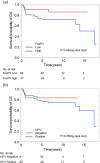Tumor-infiltrating FoxP3+ T cells are associated with poor prognosis in oral squamous cell carcinoma
- PMID: 34319010
- PMCID: PMC8874079
- DOI: 10.1002/cre2.477
Tumor-infiltrating FoxP3+ T cells are associated with poor prognosis in oral squamous cell carcinoma
Abstract
Objectives: Squamous cell carcinoma is the most common malignancy in the oral cavity. Moreover, human papillomavirus (HPV) infection has been recently implicated in the onset of oral squamous cell carcinoma (OSCC). Regulatory T cells (Tregs) are Forkhead box P3 (FoxP3) positive and are normally involved in the mechanism by which organisms escape attacks from their own immune system; however, in tumors, these cells are known to suppress antitumor immunity and block the attack against tumors. The present study evaluated the associations of the number of Tregs and HPV infection with prognoses in patients with OSCC.
Material and methods: Samples from 106 patients diagnosed with OSCC were evaluated by immunohistochemical staining for the identification of FoxP3+ Tregs and HPV. The relationship between the observed number of Foxp3-positive cells, the presence/absence of HPV infection and associations with clinicopathological indicators were analyzed.
Results: Tissues were classified into high (High) and low (Low) Treg count groups, with 69 patients classified as High and 37 classified as Low. The prognoses were significantly better in the Low group compared with the High group (p = 0.04). FoxP3 expression may have had some effect on nodal metastases (p = 0.09). HPV antigens were detected in 65 patients, but there were no significant associations with prognosis (p = 0.34). HPV-infected tumors were more common in the gums and tongues than in the lips, cheeks, and floor of the mouth (p = 0.05).
Conclusions: These results indicate that Tregs in tumor sites are associated with worsened prognoses of patients with OSCC and suggest potential therapies targeting Tregs in OSCC.
Keywords: Forkhead box P3; human papillomavirus; oral squamous cell carcinoma; regulatory T cells.
© 2021 The Authors. Clinical and Experimental Dental Research published by John Wiley & Sons Ltd.
Conflict of interest statement
All authors declare that there is no conflict of interest.
Figures


Similar articles
-
Interleukin-23 receptor defines T helper 1-like regulatory T cells in oral squamous cell carcinoma.Immun Inflamm Dis. 2022 Dec;10(12):e746. doi: 10.1002/iid3.746. Immun Inflamm Dis. 2022. PMID: 36444617 Free PMC article.
-
Detection of human papillomavirus infection in oral squamous cell carcinoma: a cohort study of Japanese patients.J Oral Pathol Med. 2016 Sep;45(8):565-72. doi: 10.1111/jop.12416. Epub 2015 Dec 29. J Oral Pathol Med. 2016. PMID: 26711722
-
Tumour infiltrating CD25+ FoxP3+ regulatory T cells (Tregs) relate to tumour grade and stromal inflammation in oral squamous cell carcinoma.J Oral Pathol Med. 2011 Sep;40(8):636-42. doi: 10.1111/j.1600-0714.2011.01020.x. Epub 2011 Feb 24. J Oral Pathol Med. 2011. PMID: 21352381
-
HPV and cancer of the oral cavity.Virulence. 2015;6(3):244-8. doi: 10.1080/21505594.2014.999570. Virulence. 2015. PMID: 25654476 Free PMC article. Review.
-
Tumor-infiltrating ICOS+ Effector Regulatory T-Cells in Oral Squamous Cell Carcinoma as a Promising Biomarker for Prognosis and 'Hot' Tumor.Anticancer Res. 2022 May;42(5):2383-2393. doi: 10.21873/anticanres.15717. Anticancer Res. 2022. PMID: 35489733 Review.
Cited by
-
Immune Modulation Through Stereotactic Radiotherapy: The Role of TBX21, GATA-3, FoxP3, and RORɣt.Medicina (Kaunas). 2025 Apr 13;61(4):717. doi: 10.3390/medicina61040717. Medicina (Kaunas). 2025. PMID: 40283008 Free PMC article.
-
Dendrimer Conjugates with PD-L1-Binding Peptides Enhance In Vivo Antitumor Immune Response.Adv Healthc Mater. 2025 Aug;14(20):e2500551. doi: 10.1002/adhm.202500551. Epub 2025 Apr 17. Adv Healthc Mater. 2025. PMID: 40244214 Free PMC article.
-
Analysis of tumor microenvironment alterations in partially responsive rectal cancer patients treated with neoadjuvant chemoradiotherapy.Int J Colorectal Dis. 2024 Jun 26;39(1):99. doi: 10.1007/s00384-024-04672-1. Int J Colorectal Dis. 2024. PMID: 38926205 Free PMC article.
-
Targeting oral tumor microenvironment for effective therapy.Cancer Cell Int. 2023 May 23;23(1):101. doi: 10.1186/s12935-023-02943-5. Cancer Cell Int. 2023. PMID: 37221555 Free PMC article. Review.
-
Immunological Response against Breast Lineage Cells Transfected with Human Papillomavirus (HPV).Viruses. 2024 Apr 30;16(5):717. doi: 10.3390/v16050717. Viruses. 2024. PMID: 38793599 Free PMC article.
References
-
- Andersen, A. S. , Koldjær Sølling, A. S. , Ovesen, T. , & Rusan, M. (2014). The interplay between HPV and host immunity in head and neck squamous cell carcinoma. International Journal of Cancer, 134, 2755–2763. - PubMed
-
- Badoual, C. , Hans, S. , Rodriguez, J. , Peyrard, S., Klein, C., Agueznay, N. E. H. , Mosseri, V. , Laccourreye, O. , Bruneval, P. , Fridman, W. H. , Brasnu, D. F. , & Tartour, E. (2006). Prognostic value of tumor‐infiltrating CD4+ T‐cell subpopulations in head and neck cancers. Clinical Cancer Research, 12, 465–472. - PubMed
-
- Binnewies, M. , Roberts, E. W. , Kersten, K. , Chan, V. , Fearon, D. F. , Merad, M. , Coussens, L. M. , Gabrilovich, D. I. , Ostrand‐Rosenberg, S. , Hedrick, C. C. , Vonderheide, R. H. , Pittet, M. J. , Jain, R. K. , Zou, W. , Howcroft, T. K. , Woodhouse, E. C. , Weinberg, R. A. , & Krummel, M. F. (2018). Understanding the tumor immune microenvironment (TIME) for effective therapy. Nature Medicine, 24, 541–550. - PMC - PubMed
-
- Elango, K. J. , Suresh, A. , Erode, E. M. , Subhadradevi, L. , Ravindran, H. K. , Iyer, S. K. , Iyer, S. K. R. , & Kuriakose, M. A. (2011). Role of human papilloma virus in oral tongue squamous cell carcinoma. Asian Pacific Journal of Cancer Prevention, 12, 889–896. - PubMed
-
- Fontenot, J. D. , Gavin, M. A. , & Rudensky, A. Y. (2017). Foxp3 programs the development and function of CD4+CD25+ regulatory T cells. Journal of Immunology, 198, 986–992. - PubMed
Publication types
MeSH terms
Substances
Grants and funding
LinkOut - more resources
Full Text Sources
Medical

